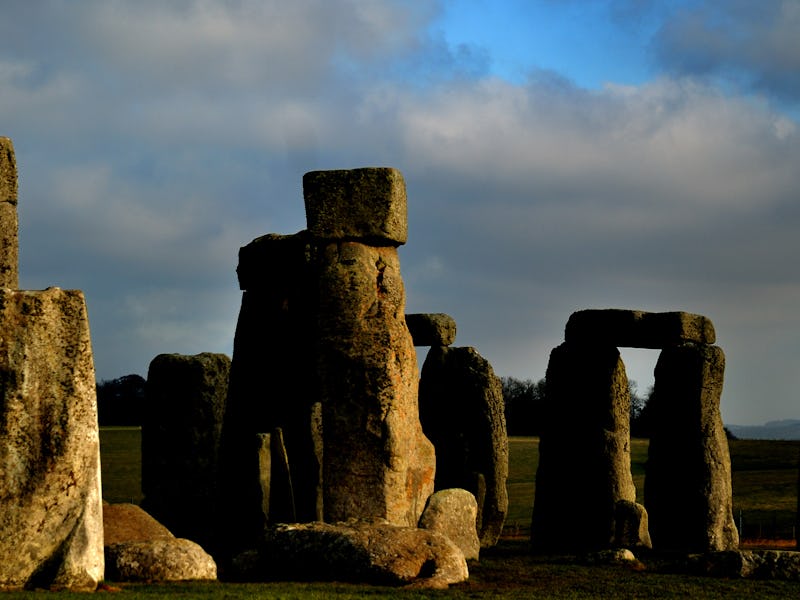In DNA Survey of Ancient Europe, Stonehenge's Creators Unexpectedly Vanish
"There was a sudden change in the population of Britain.'

Nobody is sure who built Stonehenge, the iconic ring of giant stones in the southwest of Britain: Some hypotheses peg its construction to the ancient Celtic high priests known as Druids, while others involve the Saxons, Danes, Romans, Greeks, and Egyptians. Whoever it was that built it some 5,000 years ago, we now know one thing is true, thanks to a groundbreaking pair of studies on early European migration published in Nature: They disappeared soon after it was built.
In the two papers, published Wednesday, the researchers mapped out the migration of different groups of humans across Europe, using DNA extracted from several hundred samples of ancient human bones as their guide. In the genes from bones around Stonehenge and neighboring areas, they observed something strange: around 4,500 years ago, the people who lived at Stonehenge seemed to vanish.
“There was a sudden change in the population of Britain,” said David Reich, Ph.D., a lead author of one of the papers and a population geneticist at Harvard Medical School, in a statement on Wednesday. “It was an almost complete replacement.”
Genetic data show that the people who built Stonehenge seemed to vanish from the area around 4,500 years ago.
The researchers had originally set out to figure out how and when people in prehistoric Europe — Stonehenge’s creators included — moved around, using their new wealth of genetic data extracted from the bones of 1,336 individuals. In 2014, they had only the genomes of 10 ancient Europeans and a bunch of dusty artifacts to work with; the new data, showing how those genes were passed on in both chronological and geological terms, presents a much more accurate — and often surprising — picture.
Broadly speaking, what they found is that prehistoric Europeans moved around — a lot. “There was a view that migration is a very rare process in human evolution,” said Reich, pointing out that the new findings upend that assumption: “the orthodoxy — the assumption that present-day people are directly descended from the people who always lived in that same area - is wrong almost everywhere.”
DNA from people from the Bell Beaker culture reveal that they descended from nomadic herders who migrated from the steppes of Central Asia.
That seemed to be true of the Neolithic people, hailing from the steppes of Central Asia north of the Black and Caspian seas, who ended up “replacing” the people in the area around Stonehenge.
In the study, the researchers at first focused on figuring out what drove the spread of so-called “Bell Beaker culture” — the creation of bell-shaped pots that probably started with early Iberians — throughout ancient Europe. In the past, they were never sure whether it was due to the actual migration of the people who made these pots, or whether they were simply exchanging ideas with the people around them.
Bell beakers eventually reached Stonehenge, and the data show they got there because the people who made them (mostly descendants of the Steppe people who lived in present-day Netherlands and Germany) migrated to the area — and then proceeded to replace about 90 percent of the population.
The use of stylized bell-shaped pots lspread across Europe beginning about 4,700 years ago. DNA analysis show that this so-called Bell Beaker culture was brought to Britain by people who largely replaced the island's existing inhabitants.
“This replacement is almost absolute in terms of the Y chromosome, which is transmitted by the paternal line, indicating an extreme reproductive bias, and therefore a previously unheard of social dominance,” said Carles Lalueza-Fox, Ph.D., a co-author on one of the studies and a paleogeneticist at Barcelona’s Institute of Evolutionary Biology, in a statement on Wednesday.
What happened to the “pre-Beaker” British population, who likely built Stonehenge, remains a mystery for now; one possibility is that the new migrants brought new diseases with them and killed off the local population. To figure out what happened, Reich is already working on experiments to determine how many of those individuals actually survived and stuck around in Britain.
The creation of Stonehenge may still remain a mystery, but at least the identity of the people who lived in the neighborhood is becoming slightly less murky. What’s clear is that the people currently living in present-day Europe don’t necessarily represent the people who lived there in the past: early Europeans moved around so much that it seems doubtful any one group stayed in one place for very long. Britain’s Cheddar Man, who raised the ire of many Brits in early February, illustrates this perfectly by showing that the first Britons were not blue-eyed and fair-skinned but blue-eyed and dark-skinned, suggesting that as early as 10,000 years ago, early humans from Europe, Africa, and elsewhere were already itching to make moves.
Cheddar Man, the first of many people who moved in and out of the British isles.